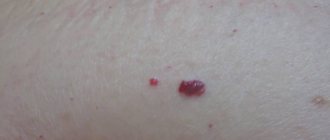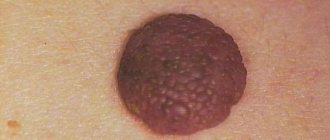Pregnancy is both a joy for a woman and a period of great trials. After all, it is at this time that, with changes in hormonal levels, she may develop pathologies and a number of diseases that the woman has never even heard of before. This includes increased blood pressure, varicose veins, and heartburn. The appearance of papillomas is also possible. What is this phenomenon? Why and where do they appear? Dangerous or not? What should the expectant mother do if they are discovered? Let's try to figure it out together.
Types of HPV
At the beginning of the 21st century, scientists have identified approximately 100 varieties of HPV. Some of them never give any manifestations on the skin, while others cause various forms of papillomas (papillomas, condylomas, plantar warts). About 30 species affect the anogenital region, that is, they are genital types of human papillomavirus infection. 13 types of HPV are causative agents of cancer. Cervical cancer is most often caused by strains 16 and 18 (70% of cases). A person can have one or several strains of the virus at the same time.
During pregnancy, the papilloma virus can become active in any part of the body: for example, plantar warts can grow, causing significant discomfort when walking. However, it is condylomas that pose a danger to the unborn baby, so it is worth discussing them in more detail.
HPV varieties that affect the perineal area are divided into those that have a low risk of cervical cancer (for example, strains numbered 6, 11) and strains with an average and high risk of developing cancer (16, 18, 31, 35, 33). Strains with a low degree of risk can cause condylomas, but do not cause dysplasia (structural changes in the mucous membranes, precancerous condition).
Papilloma virus during pregnancy
HPV on the body is a wart. On the genitals, in the episomal form of HPV infection, it manifests itself as a genital wart, which is sometimes called a genital wart. In women, it can be located in the perineum: on the labia, cervical orifice, urethra, vagina, cervix, hymen, scalp of the genitals, around the anus, in the vestibule of the rectum, sometimes in the mouth, larynx.
Very often, in the form of genital warts, the papilloma virus is noticed in women during pregnancy for the first time, although the infection itself occurred long before. Therefore, if you become pregnant and notice condylomas for the first time, do not be nervous and do not accuse your husband of cheating. The infection could have happened many years ago, including from the mother. The human papillomavirus and pregnancy is a hot topic, since it is often at this stage of life that a dormant virus wakes up from hibernation and makes itself known for the first time.
Of all the types of HPV, only strains 16 and 18 are dangerous for the baby. The remaining types of the virus should not cause any particular concern to the expectant mother, unless condylomas cause physical discomfort. Moreover, if condylomas caused by strains 18 and 16 are located outside the birth canal, they are also not dangerous for the child.
Is it necessary to remove growths during this period?
Removal of papilloma during pregnancy is not mandatory, except in exceptional cases. For example, flat warts on the arms and legs, soft growths on the face, neck and chest, armpits, stomach, back, warts on the soles and palms do not need to be removed.
Risk factors
If, after examination, the doctor concludes that removal of the papilloma is not necessary, it is better to postpone treatment until the postpartum period. However, you should be aware of possible risks that can lead to undesirable consequences:
- Mechanical impact from clothing or rubbing when walking can damage the papilloma, after which severe pain occurs and bleeding occurs. The virus can also spread to neighboring areas of the skin and lead to the appearance of new papillomas.
- The presence of the virus in the body and its activity can lead to exacerbation of chronic diseases, so you need to take precautions to avoid acquiring a new infection: avoid long walks in cold weather, observe hygiene measures, use barrier contraceptives during sex.
- Neglecting your own health during the formation of papilloma is unacceptable, therefore it is necessary to regularly be examined by a doctor (gynecologist, dermatologist), monitor changes in the color and growth of papilloma, and if new disturbing symptoms appear, be sure to visit a specialist.
- Self-medication can aggravate the situation, so you should not prescribe yourself medications, including traditional ones.
Possible complications
Most often, papillomas disappear without a trace after childbirth as suddenly as they appeared. However, the disease can result in unpleasant consequences, including:
- Child infection.
- Development of a benign tumor into a malignant one (cancer).
- Suppuration and bleeding of papilloma with subsequent penetration of infection and complications of pregnancy and childbirth.
- The growth of papilloma in the genital area can become an obstacle to natural childbirth. In this case, a caesarean section is used.
Symptoms of HPV on the genitals
The main symptom of HPV is genital warts. Despite its rather scary name, it looks harmless, like a small pink soft papilla on a thin base. A woman most often does not pay attention to such a tumor. If genital warts grow, merging, they most often resemble a bizarre sea creature or cauliflower, and then they become the cause of severe physical (rubbed with linen, interfere with shaving) and psychological (causes disgust) discomfort.
During pregnancy, the human papillomavirus often takes on a clinical form of the disease. Increased blood circulation in the tissues during pregnancy leads to the rapid growth of condyloma inflorescences, and a bright outbreak of candylomatosis begins.
Wart removal
Removal of papillomas during pregnancy worries many representatives of the fair sex. The fact is that it is still unclear whether we need to fight this problem or ignore it. Removing warts causes the problem to appear elsewhere. This happens 50% of the time. Recurrence of the pathology occurs a couple of months after surgery.
For this reason, doctors cannot recommend removing papillomas during pregnancy, and if carried out, then only if the health of the pregnant woman is threatened. The operation is carried out only with the consent of the woman in labor.
Removal of papilloma during pregnancy is done in two ways:
- Cutting out the dangling leg . This removal of papilloma is carried out by a dermatologist. The procedure does not require anesthesia, so it is safe for a woman even during pregnancy.
- Freezing . Removal of papilloma is carried out by influencing the neoplasm with a special apparatus. The procedure will also not cause harm to the expectant mother and baby.
HPV in preparation for pregnancy
The human papillomavirus in women during pregnancy can cause a lot of concern, so when planning a pregnancy, a PCR test for HPV of both future parents is necessary. We must warn you that if one of the spouses has any strain of the virus, the probability that after some time the second partner will also get it is almost 100%. In 15% of women without external signs, HPV is detected in the cervix, and this is the location of HPV that is most dangerous for infection of a newborn.
If condylomas are detected with the naked eye or during examination by a gynecologist, it is necessary to determine the type of HPV that caused the disease. A colposcopy is performed and a cytological examination is performed. Then the tumors must be removed, since they can become a “gateway” for other infections. At the same time, the doctor prescribes a course of antiviral medication. These medications are contraindicated during pregnancy, so you should first finish the course of treatment and then start trying to get pregnant again.
What to do if HPV is detected during pregnancy
If HPV is detected after a PCR test, but does not manifest itself as condylomas, its specific treatment is not required. General preventive measures are sufficient to reduce the likelihood of exacerbation:
- taking vitamins;
- stability of the nervous system, avoidance of stress;
- prevention of ARVI and other diseases.
If human papillomavirus is detected in the form of condylomas during pregnancy, the doctor decides whether treatment is necessary, since condylomas during natural childbirth:
- are a source of infection for the baby;
- can cause mechanical and hemorrhagic (bleeding) complications during childbirth.
Papillomas on the cervix during pregnancy in rare cases cause laryngeal papillomatosis in the newborn, so the doctor may recommend a cesarean section. Infection occurs if the baby takes a breath prematurely while still in the womb. Caesarean section due to HPV is very rare. It is used only in the case of giant condyloma, a condition usually characteristic of HIV-positive women.
The human papillomavirus in pregnant women, which leads to dysplasia, is a dangerous phenomenon for both the expectant mother and the growing child. Dysplasia is defined in three degrees:
- weak (CIN 1);
- medium (CIN 2);
- severe (CIN 3).
Unfortunately, detection of dysplasia in the third stage usually requires termination of pregnancy in the early stages. Naturally, the final decision is made by the doctor and the patient. Dysplasia of the 1st and 2nd degrees does not require abortion; drug treatment and removal of condylomas are carried out.
Most often, if the fact of cervical cancer in a pregnant woman is established, and the depth of invasion (penetration into adjacent tissues) is no more than 3 mm, the doctor performs a partial removal of the cervix. About a month and a half after birth, the uterus is completely removed.
Consequences for the child
The mother's disease risks infecting the child with HPV during childbirth. In practice, these cases are less than 50%, but they exist. HPV in a baby does not always appear immediately; it can only happen after several months or even years.
However, there are cases of rapid manifestations when the virus affects the larynx of a newborn. This picture is observed in the first month of his life and is fraught with serious consequences.
Some experts advocate performing a caesarean section in infected women, but this is not confirmed by experience, since HPV is transmitted to the child during such births.
In cases where the virus infects the trophoblast (future placenta), which nourishes the embryo, the pregnancy is terminated in the early stages.
Treatment of papillomas in pregnant women
Doctors do not have a single solution on the issue of treating papilloma during pregnancy. Some are inclined to believe that it is necessary to remove tumors as early as possible. Others delay removal until the last trimester, since often the immune system returns to normal and the condylomas disappear on their own.
Condylomas caused by the human papillomavirus in women and pregnancy force the doctor to make a decision: is the risk of removing warts justified, or is it possible to postpone the procedure until the pregnancy is resolved. The decision to remove genital warts is made in cases where:
- the growths take on significant dimensions and interfere with normal life, causing pain from contact with underwear;
- growths bleed;
- warts interfere with physiological processes - urination, defecation.
Regarding removal methods, doctors are more unanimous: laser and liquid nitrogen, widely used to combat tumors, are contraindicated for expectant mothers. More gentle methods are chosen. New growths on the cervix are removed no earlier than 14 weeks. The radio wave method (electric loop) is considered the most gentle. At the same time, medications that boost immunity and vitamins are prescribed.
Condylomas on the skin, if they are very bothersome, with the permission of the doctor leading the pregnancy, can be removed with certain pharmaceutical drugs (for example, solcoderm). If the doctor decides not to treat papillomas during pregnancy, there is a high chance that they will go away within 100 days after birth.
HPV prevention
Most often, infection occurs through sexual contact. A condom will not protect against HSV, since the virus is transmitted not only through secretions from intimate places, but also through saliva, urine and pieces of skin. Accordingly, the only effective way of prevention is to limit the number of sexual partners.
Although HPV is classified as an STD, the virus is transmitted through the skin and mucous membranes of a person, and therefore even the complete absence of sexual contact is not a 100% guarantee of safety. To prevent any type of HPV, it is important to follow standard hygiene measures, including washing new underwear before use.
The most dangerous to the health of any person are 2 types of papillomavirus. There is one reliable way to protect your child from cancer of the cervix, rectum and head of the penis, as well as other troubles caused by strains 16 and 18 in the future: vaccination. In Russia, for teenagers 12-13 years old, it is held free of charge at their place of residence. Vaccination is carried out in 3 stages.
There are currently 2 vaccines in use:
- Gardasil - used for vaccination of girls and boys aged 9-17 years, as well as girls aged 18-26 years;
- Cervarix – for girls from 10-25 years old.
It is recommended to get vaccinated even if one of the 2 listed strains (16 or 18) is already in the body. This vaccination is absolutely necessary for those who have a family history of cervical cancer. Vaccines have shown 99% effectiveness in the fight against cervical cancer, 95% effectiveness in the fight against genital warts.
Women who are found to have oncogenic strains of the virus must be examined twice a year for dysplasia and the development of oncology. All people should be attentive to all new growths on the skin, and conduct histological studies of these objects.
In general, we can conclude that the papilloma virus and pregnancy are not a very scary combination. HPV does not affect the course of pregnancy and does not lead to deviations in the development of babies. For a little person, only tumors located in the birth canal are dangerous. For a pregnant woman, HPV is dangerous due to weakening of the immune system, the ability of this virus to “open the way” to other infections into the body, therefore it is recommended to undergo a course of treatment for papillomavirus before the planned pregnancy or in its last stages.
Causes of HPV in pregnant women?
One of the main reasons for the activation of the virus is, of course, a decrease in immunity. All the body’s forces are aimed at ensuring the growth and development of the baby, so the protection of the expectant mother is significantly weakened.
In addition, there are several other provoking factors:
- Hormonal changes . Excessive amounts of certain hormones can lead to proliferation of epidermal cells.
- Mechanical impact and skin friction . A woman’s weight is rapidly growing, her previous clothes become tight, and wrinkles form on the skin. In this regard, when walking and moving, rubbing of the skin occurs, and papillomas appear in these places.
Regardless of the reason that caused the appearance of papilloma, papillomatosis always indicates that a virus is present in the body.











